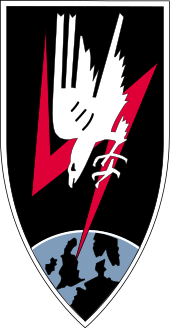Night hunting
The night hunting is from the First World War established procedure to night fly-enemy bomber or reconnaissance aircraft to fight through their own aircraft. During the First World War, for example , the British Royal Air Force fought German airships approaching London at night . From 1942/43 the German Air Force built the most powerful night fighter weapon of the Second World War due to the permanent bombing of the German sphere of influence by the British RAF Bomber Command .
history
During the Second World War, German night hunting is often cited as the only example of this form of aerial combat , even though all nations participating in the war had suitable forces ready for night hunting. This has to do with the fact that from 1941 the German Reich territory, as well as the occupied territory of Western Europe, were constantly threatened by night attacks by British bombers. These attacks have increased continuously since the spring of 1942, when the so-called "1000 bomber attack" took place on Cologne. In addition, the British RAF Bomber Command has been increasingly supported by the US Air Force since 1942 .
Night hunting proceedings
"Wild Pig"
From 1943, experiments were carried out with the “ Wilde Sau ” night hunting method developed by Major Hajo Herrmann . For this concept, regular single-engine fighter aircraft of the Jagdgeschwader 300 were used. They had no radar and therefore had to fly by sight. For the "Wilde Sau", the air space above the bombed area was illuminated by flak searchlights and light ammunition fired by the flak. Added to this was the reflection of the fires from the ongoing attack from the ground. The day fighters were able to recognize and attack the bombers against the illuminated background. With the use of “Wilde Sau”, the hunting successes of the German air defense increased considerably; As a countermeasure, the British units and American bomber groups formed the so-called " Combat Box " shortly afterwards . Three groups of bombers form a squadron, which means that the day fighters, so the thought, could hardly penetrate.
Radio measurement method


The pinnacle of technical development were night fighters , who conducted their own final approach to the bombers using on-board radar. The following were used:
- active: FuG 220 "Lichtenstein" (91 MHz, 2.5 kW pulse power)
- passive: homing device FuG 370 Naxos for approach to British H2S radar
- passive: homing device FuG 227 Flensburg for the approach to the British "Monica" distance warning device
Since larger machines were required for this, twin-engine aircraft were used initially, such as the Messerschmitt Bf 110 or, when their power was no longer sufficient, the Junkers Ju 88 . But airplanes were also specially developed for this form of aerial combat; an example of this is the Heinkel He 219 , which was officially attacked because of this specialization.
"Tame Pig"
In the operational tactics "Tame Sau" gathered with radar-equipped twin-engine night fighters after penetration of enemy bombers in the air and on-board radars were located with the help of their targets over large distances involved. They were also of the ground-based radar stations of kammhuber line support which reported the bearings of enemy bombers. The greatest success of the radar-guided night chase was the air raid on Nuremberg on March 31, 1944, in which 95 four-engine RAF bombers were shot down.
"Strange music"
A special chapter is the development of so-called "weird music" . Two machine guns were installed in the rear fuselage area in such a way that they fired upwards at an angle. The pilot flew under the enemy bomber and then deployed the raised weapons. This procedure also covered the attacking fighter, as he was able to escape the firing range of the rear gunner. It was assumed initially machine guns, during the war 20 mm were machine guns and later even 30 mm MKs ( MK 108 or MK 103 ) installed, which were much more effective.
German night fighter squadron
- Night Fighter Squadron 1
- Night Fighter Squadron 2
- Night Fighter Squadron 3
- Night Fighter Squadron 4
- Night Fighter Squadron 5
- Night Fighter Squadron 6
- Night Fighter Squadron 7
- Night Fighter Squadron 11
- Night Fighter Squadron 100
- Night Fighter Squadron 200
- Nachtjagdgruppe 10 , a test association
See also
literature
- Olaf Groehler : History of the Air War , Military Publishing House of the GDR, Berlin, 1981.
- Fritz Trenkle : The German radio control procedures until 1945 , Dr. Alfred Hüthig Verlag Heidelberg, 1987, ISBN 3-7785-1647-7 .
- Gebhard Aders : History of the German night hunt , Motorbuch Verlag, 1977, ISBN 3-87943-509-X .

